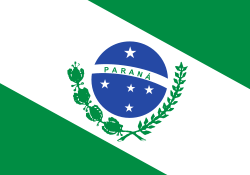Paraná (state)
Paraná (Brazilian Portuguese: [paɾɐˈna] (![]()
State of Paraná Estado do Paraná | |
|---|---|
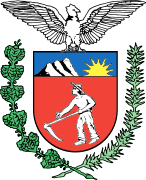 Coat of arms | |
| Anthem: Hino do Paraná | |
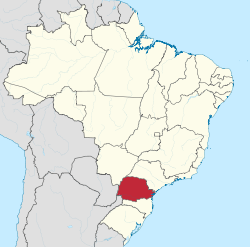 Location of State of Paraná in Brazil | |
| Coordinates: 24°0′S 51°0′W | |
| Country | |
| Founded | December 19, 1853 |
| Capital and Largest City | Curitiba |
| Government | |
| • Governor | Ratinho Júnior (PSD) |
| • Vice Governor | Darci Piana (PSD) |
| • Senators | Alvaro Dias (PODE) Flávio Arns (Rede) Oriovisto Guimarães (PODE) |
| Area | |
| • Total | 199,314.9 km2 (76,955.9 sq mi) |
| Area rank | 15th |
| Population (2010)[1] | |
| • Total | 10,444,526 |
| • Estimate (2019) | 11,433,957 |
| • Rank | 6th |
| • Density | 52/km2 (140/sq mi) |
| Demonym(s) | Paranaense |
| GDP | |
| • Year | 2015 estimate |
| • Total | US$203 billions (PPP) US$114 billions (nominal) (5th) |
| • Per capita | US$17,982 (PPP) US$10,109 (nominal) (6th) |
| HDI | |
| • Year | 2017 |
| • Category | 0.792[2] - high (4th) |
| Time zone | UTC-3 (BRT) |
| • Summer (DST) | UTC-2 (BRT) |
| Postal Code | 80000-000 to 87999-999 |
| ISO 3166 code | BR-PR |
| Website | pr.gov.br |
Its area is 199,307.9 km2 (76,953.2 sq mi), and it is subdivided into 399 municipalities. Its capital is the city of Curitiba. Other major cities are Londrina, Maringá, Ponta Grossa, Cascavel, São José dos Pinhais and Foz do Iguaçu.
Crossed by the Tropic of Capricorn, Paraná has what is left of the araucaria forest, one of the most important subtropical forests in the world. At the border with Argentina is the National Park of Iguaçu, considered by UNESCO as a World Heritage site. At only 40 km (25 mi) from there, at the border with Paraguay, the largest dam in the world was built, the Hidroelétrica de Itaipu (Itaipu Hydroelectric Dam). The crime rate is considered low by Brazilian standards[5] and the state is one of the most developed ones in the nation,[6] ranking 4th in gross domestic product, only behind the states of Rio de Janeiro, São Paulo and Minas Gerais.[7]
The state has 5.4% of the Brazilian population (Paraná had 11.4 million people in 2019[8], and Brazil had 210 million inhabitants in the same year)[9], and 6.2% of national GDP (Paraná's GDP was R$ 452.7 billion in 2019[10], and Brazil's GDP was R$ 7.3 trillion).[11]
History
Before the discovery of the region by European explorers, indigenous populations inhabited the region for thousands of years. This included the Carijó in the lands closer to the sea, from the Tupi group, and the Caingangues in the interior, who belonged to the Jê group.[12]
Colonisation of the state by settlers started in the 16th century, but was mainly confined to the coasts. Being a region mostly abandoned by the Portuguese,[13] the region was explored by other European countries, who searched primarily for Pau brasil.[13] The most noteworthy presence was that of the Spanish, which brought with them jesuits. Soon, Jesuit reductions were opened in the western and south-western parts of the state, whose territory largely belonged to the Spanish crown. In 1554, Domingo Martínez de Irala founded the town of Ontiveros, one league away from the Guaíra Falls.[14]
In the 1940s, the northern part of the state was settled as a result of the expansion of the São Paulo coffee industry. The south-eastern part of the state was settled as a result of migration from Rio Grande do Sul.[15]
Geography
Paraná is bounded on the north by São Paulo state, on the east by the Atlantic Ocean, on the south by Santa Catarina state and the Misiones Province of Argentina, and on the west by Mato Grosso do Sul and the republic of Paraguay, with the Paraná River as its western boundary line.
The state can be separated into five main topographic areas, from east to west: a coastal zone, the mountains of Serra do Mar, and then three plateaus, each lower than the other, until the Paraná River is reached.[16]
Climate
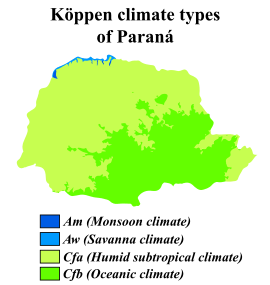
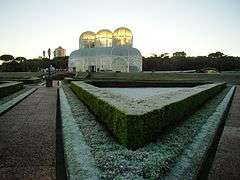
According to the Köppen climate classification, the north and west of the state, and the east coast, is of the Cfa climate type, with the remainder being Cfb.[17] An alternative analysis using the ECMWF model indicates that the Aw and Cwa Köppen types appear in the north.[18] The northern part of the state is the convergence point between the Tropical Atlantic and Equatorial Continental air masses.[19]
Temperature and precipitation
The annual mean air temperature ranges between 15 and 24°, with the highest temperatures found in the northwest and the lowest around Palmas,[18] which is considered the coldest city of Paraná by the meteorological body Simepar.[20] In the coastal plain minimum average temperatures range between 16–18 °C (61–64 °F).[21]
Precipitation is less than 1,200 mm (47 in) a year in the north of the state, rising to above 1,800 mm (71 in) in the southwest and southeast of the state.[18]
Climate subtypes
The Cfa climate, subtropical with good distribution of annual rainfall and hot summers, occurs in the coastal plain and western parts of the state. Average temperature is 19 °C (66 °F), with rainfall of 1,500 millimetres (59.1 in) per year.[22]
The Cfb climate, warm to hot temperate with good distribution of annual rainfall and mild summers, occurs at higher elevationu. The average annual temperatures are 17 °C (63 °F) and rainfall of 1,200 millimetres (47.2 in) per year.[22]
The Cwa climate, subtropical with hot summers and dry winters, has occurred in the north-western part of the state territory. It is what is called a tropical climate, because in contrast to the two described above, whose good distribution of rainfall is registered throughout the year, this has characteristic rainy index of tropical systems, with dry winters and wet summers. The thermal medium per year varies around 20 °C (68 °F) and the wet content amounts to 1 millimetre (0.0 in) to 300 millimetres (11.8 in) per year. Almost the entire state territory is subject to a great number of frost per year.[22] Cities with this climate include Paranavaí (according with Maack) with some characteristics - Cfa(h), transition with a humid climate all year round.[23]
Demographics
| Year | Pop. | ±% p.a. |
|---|---|---|
| 1872 | 126,722 | — |
| 1890 | 249,491 | +3.84% |
| 1900 | 327,136 | +2.75% |
| 1920 | 685,711 | +3.77% |
| 1940 | 1,236,276 | +2.99% |
| 1950 | 2,115,547 | +5.52% |
| 1960 | 4,296,375 | +7.34% |
| 1970 | 6,997,682 | +5.00% |
| 1980 | 7,749,752 | +1.03% |
| 1991 | 8,443,299 | +0.78% |
| 2000 | 9,558,454 | +1.39% |
| 2010 | 10,444,526 | +0.89% |
| 2018 | 11,348,937 | +1.04% |
| source:[24] | ||
Parana is the sixth most populous state in Brazil. Its level of urbanization is 83.5%.[25]
Ethnic groups
The 2005 IBGE survey gave the following breakdown by race for the state: White (Branca) 73.0%, Pardo (mixed) 23.3%, Black (Preta) 2.5%, and Indigenous 1.2%.[26]
Parana's white population is primarily descendant of Portuguese, Italian, Polish and Ukrainian immigrants, but many German families also settled in the state.[27] A variation of German known as Paraná-Wolga-Deutsch originated in the area.[28]
Initially settled by the Guarani and Kaingang Amerindians, until the 17th century, virtually no European presence existed in Paraná. The number of settlers grew around 1750 and the population was composed of Amerindians, Portuguese, and some Spaniards. African slaves from Angola and Mozambique were also present, but in fewer numbers than in other Brazilian areas, because Paraná was an unexplored region that did not need much slave manpower. As part of the province of São Paulo, immigration grew in the mid-19th century, mostly composed of Italian, German, Polish, Ukrainian, and Japanese peoples. While large numbers of Poles and Ukrainians are present in Paraná, their presence in the rest of Brazil is relatively small, especially Ukrainians. In the early 20th century, two waves of migration to Paraná occurred: one coming from the north, mostly of Portuguese, but also of African and Amerindian origin, and another from southern Brazil to the southwest and west, mostly of Portuguese, Italian, and German origins.[29][30]
Major cities
Economy
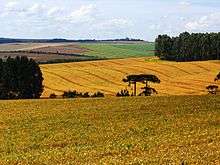
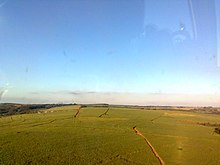
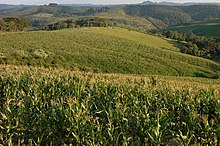
In 2013, the Paraná had the fifth largest GDP of Brazil, representing 5.90% of the Brazilian GDP in 2005, against 6.4% in 2003.
About 15% of Paraná's GDP comes from agriculture. Another 40% comes from industry and the remaining 45% comes from the tertiary sector. As for its exports, in 2012 the main products exported were soybeans (18.73%), Meat Poultry (10.50%), sugar in Natura (8.09%), Soybean Meal (8.00%) and corn (6.36%).[32] The state's largest company is the government-owned Copel, which supplies electricity, natural gas and other utilities to Paraná and some surrounding areas and in 1997 was among the first Brazilian companies to be listed on the New York Stock Exchange (ELP).
The main economic activities are agriculture, industry (agribusiness, automotive, and paper) and plant extraction (wood and yerba mate).[33] Despite the good social indicators and high standard of living, unemployment is still a problem and the state is one of most difficult for foreigners trying to find jobs.[34]
In agriculture, the state stands out in the production of soybeans, corn, wheat, sugarcane, cassava, beans, tomato, orange and yerba mate, in addition to also producing coffee, oat, barley, peach, tangerine and strawberry.
In 2020, the South Region produced 32% of the national total of cereals, vegetables and oilseeds. There were 77.2 million tons, second place in Brazil, losing only to the Midwest. Paraná (14.9%) was the 2nd largest producer in the country.[35]
In soy, Paraná is the 2nd largest producer in the country, with about 16% of national production. It produced 19.8 million tons in 2020.[36][35] In 2017, it was also 2nd largest producer of corn.[37][38][39] Brazil is the biggest producer of soy and the 2nd biggest producer of corn in the world.
Regarding sugarcane, Paraná was, in 2017, the fifth largest producer of cane, third of sugar and fifth of alcohol in the country. It harvested about 46 million tons of cane this year. The state's sugar and alcohol sector has 25 plants and employs around 55,000 people. The regions of Umuarama, Paranavaí, Maringá and Jacarezinho concentrate production. Brazil is the largest world producer, with 672.8 million tons harvested in 2018.[40][41]
In cassava production, Brazil produced a total of 17.6 million tons in 2018. Paraná was the 2nd largest producer in the country, with 3.2 million tons.[42]
Since 2006, Paraná has been leading the production of beans in Brazil. Brazil is the 3rd largest producer of beans in the world, with an annual harvest of around 3 million tons, 11% of world production. In 2018, the South Region was the main bean producer with 26.4% of the total, followed by the Midwest (25.4%), Southeast Region (25.1%), Northeast (20.6%) and North (2.5%). The State of Paraná leads the ranking of the main national producers with 18.9% of the total produced.[43][44]
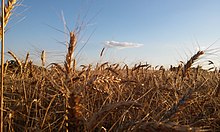
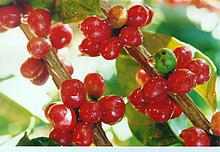
Paraná is the 2nd largest national producer of wheat, with 2.2 million tons in 2019, almost equal to Rio Grande do Sul, the biggest producer.[35][45][46] The South Region is also the largest producer of oats in Brazil. In 2019, national production was close to 800 thousand tons, being almost all carried out in the South (Paraná and Rio Grande do Sul).[47][48]
About orange, Paraná was the 3rd largest producer in Brazil in 2018, with a total of 834 thousand tons.[49]
Although not a large production, Paraná is the Brazilian leader in the production of barley. The state harvested 219.2 thousand tons in 2019, 60% of the national production. However, Brazil is far from being self-sufficient in the production of barley. The Brazilian market consumes, on average, 1.5 million tons per year. Brazil produces 335 thousand tons, close to 22%. Most, 73%, come from Argentina and Uruguay.[50][51]
In 2018, Paraná was the 4th largest produce of tangerine in Brazil.[52] Paraná also has a part of the production of peaches in Brazil.[53] In 2019, in Brazil, there was a total production area of around 4 thousand hectares of strawberry. Paraná was the 4th largest producers in the country.[54]
In coffee, Paraná is the producer state located further south in the country. It was once the largest producing state in Brazil: in 1962, Paraná accounted for 58% of national production, but in 2017, it had only 2.7% of the total produced in the country. The coffee culture has been replaced by other planting crops, and the state's focus today has been to invest in special, more expensive coffee beans.[55][56]
In 2019, Brazil produced about 900 thousand tons of yerba mate annually, according to the IBGE. Paraná is the largest producer in volume and Rio Grande do Sul in plantation areas (and where the sector is more industrialized). According to 2017 data, Paraná harvested 301 thousand tons of yerba mate by extractive method, and 237 thousand tons in plantation. The productive potential of yerba mate is still little explored in Brazil, with a good part of the harvest carried out by the extractive system and with low levels of productivity. However, many new producers are adopting more professional and efficient production systems, with technical acuity of management and globalized market vision. This tends to increase Brazil's export of this product.
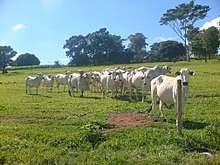
In 2017, the state's cattle herd was 9.3 million head, 10th place in the country.[57]
In 2018, Paraná produced a total of 4.4 billion liters of milk, making it the 2nd largest producer in the country. The city of Castro was the largest producer in the country in 2018, with 292 million liters of milk.[58]
In pork, the 3 southern states are the largest producers in the country. Brazil had 41.1 million head in 2017. Paraná (17.2%) is the 2nd largest producer.[59][60][61]
The Brazilian poultry flock, in 2018, was of the order of 1.5 billion heads. In 2017, the biggest poultry producing state in Brazil was Paraná (25.3%). In terms of chickens, in 2017 there were 242.8 million heads in the country. Among the states that were the largest producers, São Paulo led with 21.9%, followed by Paraná (10.1%).[62] In the production of chicken eggs, the state ranks 2nd in Brazil, with 9,6% of national production.[63]
In fish farming, western Paraná, in municipalities close to Toledo and Cascavel, has become the largest fish-producing region in the country, with tilapia as the main cultivated species. The west represents 69% of all production in Paraná, the largest national producer, with 112 thousand tons. Of this amount, 91% refer to tilapia breeding.[64]
The South region was the main producer of honey in the country in 2017, accounting for 39.7% of the national total. Paraná was the 2nd largest producer in the country, with 14.3%.[65]
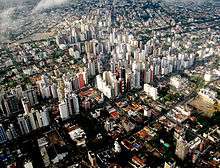
About industry, Paraná had an industrial GDP of R $ 92.8 billion in 2017, equivalent to 7.8% of the national industry. It employs 763,064 workers in the industry. The main industrial sectors are: Food (19.1%), Industrial Services of Public Utility, such as Electricity and Water (18.5%), Construction (17.3%), Motor Vehicles (8.1%), and Petroleum Derivatives and Biofuels (5.7%). These 5 sectors concentrate 68.7% of the state's industry.[66]
In Brazil, the automotive sector represents close to 22% of industrial GDP. In 2019 the state went to the 2th place in national vehicle production, with 15% participation. The state has Volkswagen, Renault, Audi, Volvo and DAF plants.[67]

In the paper and cellulose sector, Brazilian pulp production was 19.691 million tons in 2019. The country exported US $ 7.48 billion in pulp this year, US $ 3.25 billion only to China. Brazilian forest-based industry exports totaled US $ 9.7 billion (US $ 7.48 billion in cellulose, US $ 2 billion in paper and US $ 265 million in wood panels). Paper production was 10.535 million tons in 2019. The country exported 2.163 million tons. In 2016, the paper and cellulose industry in the South of the country represented 33% of the national total. This year, Paraná was the national leader in the production of roundwood (mainly eucalyptus) for the pulp and paper industry (15.9 million m³); Brazil was the second country that produced the most cellulose in the world and the eighth in the production of paper. The city that most produced these woods in Brazil was Telêmaco Borba (PR), and the 5th largest was Ortigueira (PR).[68][69][70] In 2016, the top five states producing logs for paper and cellulose (mainly eucalyptus) were: Paraná (15.9 million m³), São Paulo (14.7 million m³) , Bahia (13.6 million m³), Mato Grosso do Sul (9.9 million m³) and Minas Gerais (7.8 million m³). Together, they correspond to 72.7% of the national production of 85.1 million m³. The ten largest producing municipalities had 22.9% of the country's production. They were the cities of Telêmaco Borba (PR), Três Lagoas (MS), Caravelas (BA), Mucuri (BA), Ortigueira (PR), São Mateus (ES), Dom Eliseu (PR), Nova Viçosa (BA), Water Clara (MS) and Ribas do Rio Pardo (MS).[71][70]
Paraná is the largest producer of oil shale in Brazil. In the city of São Mateus do Sul, there is a Petrobras plant specialized in the production of the material. Approximately 7,800 tons are processed daily.[72]
In Food industry, In 2019, Brazil was the 2nd largest exporter of processed foods in the world, with a value of U $ 34.1 billion in exports. The Brazilian food and beverage industry's revenue in 2019 was R $ 699.9 billion, 9.7% of the country's Gross Domestic Product. In 2015, the industrial food and beverage sector in Brazil comprised 34,800 companies (not counting bakeries), the vast majority of which were small. These companies employed more than 1,600,000 workers, making the food and beverage industry the largest employer in the manufacturing industry. There are around 570 large companies in Brazil, which concentrate a good part of the total industry revenue. Paraná created food companies of national importance such as Frimesa, C.Vale, Nutrimental, Copacol, Coopavel and Matte Leão.[73][74][75]
In Electronics industry, the turnover of industries in Brazil reached R $ 153.0 billion in 2019, about 3% of the national GDP. The number of employees in the sector was 234.5 thousand people. Exports were US $ 5.6 billion, and the country's imports were US $ 32.0 billion. Brazil, despite its efforts over the decades to get rid of the dependence on technology imports, has not yet managed to reach this level. Imports are concentrated in expensive components, such as processors, microcontrollers, memories, under-mounted magnetic disks, lasers, LED and LCD. Cables for telecommunication and electricity distribution, wires, optical fibers and connectors are manufactured in the country. Brazil has two large electro-electronic production hubs, located in the Metropolitan Region of Campinas, in the State of São Paulo, and in Free Economic Zone of Manaus, in the State of Amazonas. There are large internationally renowned technology companies, as well as part of the industries that participate in its supply chain. The country also has other smaller centers, and one of them is at Curitiba, capital of Paraná.[76][77]The technological center of Curitiba has companies such as Siemens and Positivo Informatics. In all, 87 companies and 16 thousand employees work at Tecnoparque, an area of 127 thousand square meters created by state law in 2007. Tecnoparque can grow up to 400 thousand square meters and receive up to four times the number of workers it has today, reaching 68 thousand people.[76]
In the household appliances industry, sales of so-called "white line" equipment (refrigerator, air conditioning and others) were 12.9 million units in 2017. The sector had its peak sales in 2012, with 18.9 million units. The brands that sold the most were Brastemp, Electrolux, Consul and Philips. Brastemp is originally from São Bernardo do Campo-SP. Consul is originally from Santa Catarina, having merged with Brastemp and today being part of the multinational Whirlpool Corporation. Another famous Brazilian brand was Prosdócimo, founded in Curitiba, which was sold to Electrolux.[78]
In the small appliances sector, Paraná has one of the famous companies: Britânia, originally from Curitiba.
Infrastructure
International airports
- Afonso Pena International Airport is Curitiba's main airport. It is located in the nearby city of São José dos Pinhais.
- Foz do Iguaçu International Airport
Sports
Two of the biggest football sides in the state are Clube Atlético Paranaense and Coritiba Foot Ball Club, who play the Atletiba derby.[79] Curitiba was one of the 12 host cities of the 2014 FIFA World Cup.
See also
References
- "POPULAÇÃO RESIDENTE, EM 1o DE ABRIL DE 2007, SEGUNDO AS UNIDADES DA FEDERAÇÃO" (PDF) (in Portuguese). IBGE. Retrieved 21 April 2013.
- "Radar IDHM: evolução do IDHM e de seus índices componentes no período de 2012 a 2017" (PDF) (in Portuguese). PNUD Brasil. Retrieved 18 April 2019.
- In Brazilian Portuguese. The European Portuguese pronunciation is [pɐɾɐˈna].
- Chisholm, Hugh, ed. (1911). . Encyclopædia Britannica. 20 (11th ed.). Cambridge University Press. p. 766.
- Paraná, Jornal Bem. "Jovem é assassinado com vários tiros em Campo Largo -". www.bemparana.com.br (in Portuguese). Retrieved 29 January 2019.
- Pamplona, Nicola (28 November 2016). "Estados mais ricos ainda concentram PIB, mas participação cai, diz IBGE". Bem Paraná. Archived from the original on 29 November 2016.
- "Contas Regionais 2014: cinco estados responderam por quase dois terços do PIB do país". IBGE. 28 November 2016. Archived from the original on 28 July 2017. Retrieved 23 November 2018.
- Com 11,4 milhões de habitantes, Paraná é o quinto estado mais populoso do país, diz IBGE
- Estimativa de população do Brasil passa de 210 milhões
- PIB DO PARANÁ -RESULTADOS DO 3⁰TRIMESTRE DE 2019
- O que é o PIB
- CELEPAR. "Etnias - Estado do Paraná". www.cidadao.pr.gov.br (in Portuguese). Archived from the original on 16 January 2014. Retrieved 1 May 2018.
- Mascarenhas, Maria Amélia; Biasi, Mauro De; Coltrinari, Lylian; Moraes, Antônio Carlos de Robert de (1998). "Paraná". Grande Enciclopédia Larousse Cultural (in Portuguese). 18. São Paulo: Nova Cultural. pp. 4444–4445.
- "Estado do Paraná". Encontra Paraná. 2017. Retrieved 31 July 2018.
- "Supporting the Contribution of HEIs to Regional Development" (PDF). Secretariat of Science, Technology and Higher Education, State of Parana. Retrieved 21 April 2013.
- "Paraná". Encyclopædia Britannica. Retrieved 6 January 2013.
- "Atlas Climatico do Paraná" (in Portuguese). Instituto Agronômico do Paraná - IAPAR. Retrieved 1 May 2020.
- Lucas Eduardo de Oliveira Aparecido, Glauco de Souza Rolim, Jonathan Richetti, Paulo Sergio de Souza, Jerry Adriani Johann (2016). "Köppen, Thornthwaite and Camargo climate classifications for climatic zoning in the State of Paraná, Brazil". Ciência e Agrotecnologia. Lavras. 40 (4): 405–417. doi:10.1590/1413-70542016404003916. ISSN 1413-7054. Retrieved 3 May 2020.CS1 maint: multiple names: authors list (link)
- Nice Lecocq Müller (2001). "Contribuição ao estudo do norte do Paraná". GEOGRAFIA (Londrina) (in Portuguese). 10 (1): 89–119. doi:10.5433/2447-1747.2001v10n1p89 (inactive 6 March 2020). ISSN 2447-1747. Retrieved 2 May 2020.
- "Parecer do Simepar confirma Palmas como a mais fria do Paraná" (in Portuguese). Prefeitura Municipal de Palmas. 18 April 2018. Retrieved 9 May 2020.
- Felipe Vanhoni, Francisco Mendonça (August 2008). "O Clima do Litoral do Estado do Paraná" (in Portuguese). Revista Brasileira de Climatologia. p. 5. Retrieved 2 May 2020.
- Garschagen 1998, p. 133-134.
- "Evolução climática do Estado do Paraná" (PDF).
- IGBE
- "Brazil will improve the urban infrastructure in the state of Paraná". Inter-American Development Bank. 18 December 2014. Retrieved 1 May 2020.
- "Tabela 9.1 - População total e respectiva distribuição percentual, por cor ou raça, segundo as Grandes Regiões, Unidades da Federação e Regiões Metropolitanas - 2005" (PDF). Síntese de indicadores sociais 2006 (in Portuguese). IBGE. p. 248. Archived from the original (PDF) on 8 October 2013. Retrieved 1 May 2020.
- Higher Education in Regional and City Development: State of Paraná, Brazil (PDF). OECD. 2011. p. 38. ISBN 978-92-64-089020.
- "Wayback Machine (Indo-European phylosector)" (PDF). 31 December 2005. Archived from the original (PDF) on 31 December 2005. Retrieved 29 January 2019.
- Saloum De Neves Manta, Fernanda; Pereira, Rui; Vianna, Romulo; Rodolfo Beuttenmüller De Araújo, Alfredo; Leite Góes Gitaí, Daniel; Aparecida Da Silva, Dayse; De Vargas Wolfgramm, Eldamária; Da Mota Pontes, Isabel; Ivan Aguiar, José; Ozório Moraes, Milton; Fagundes De Carvalho, Elizeu; Gusmão, Leonor (2013). "Revisiting the Genetic Ancestry of Brazilians Using Autosomal AIM-Indels". PLOS ONE. 8 (9): e75145. doi:10.1371/journal.pone.0075145. PMC 3779230. PMID 24073242.
- HLA polymorphism and evaluation of European, African, and Amerindian contribution to the white and mulatto populations from Parana, Brazil
- "Brazil: Paraná". City Population. Retrieved 20 April 2016.
- "Exportações do Paranpa (2012)". Plataforma DataViva. Archived from the original on 14 January 2014. Retrieved 13 January 2014.
- MANTOVANI, Ana Margô (June 2003). "Paraná: Economia". Laboratórios de Informática Unilasalle. Archived from the original on 18 January 2012. Retrieved 15 July 2011.
- Portal, Mariana Ohde Repórter no Paraná (18 August 2017). "Taxa de desemprego fica em 8,9% no Paraná". Paraná Portal (in Portuguese). Retrieved 29 January 2019.
- IBGE prevê safra recorde de grãos em 2020
- Confira como está a colheita da soja em cada estado do país
- Quatro estados concentram quase 70% da produção de grãos do país
- Produção de Milho no Nordeste
- Produção de grãos cresce 14% e Piauí se consolida como 3º maior produtor do Nordeste
- Paraná deve colher até 46 milhões de toneladas de cana-de-açúcar
- Produção de cana de açúcar no Nordeste
- Produção brasileira de mandioca em 2018
- Feijão - Análise da Conjuntura Agropecuária
- Paraná é líder na produção de feijão no País
- Rio Grande do Sul deve superar Paraná na produção de trigo em 2019
- BRASIL - IMPORTAÇÃO DE TRIGO 2019 (POR PAÍS)
- Em abril, IBGE prevê alta de 2,2% na safra de grãos de 2019
- Alternativa ao trigo, cevada ganha espaço no Sul e projeta produção recorde
- Produção brasileira de laranja em 2018
- Maior produtor de cevada, Paraná registra alta de 32% na safra
- A Cevada no Brasil
- Produção brasileira de tangerina em 2018
- Como plantar pêssego
- Qual o panorama da produção de morango no Brasil?
- O café brasileiro na atualidade
- A Reivenção da cafeicultura no Paraná
- Situação Conjuntural dos Últimos Anos e Prognóstico da Pecuária de Corte
- Paraná é o segundo maior produtor de leite do Brasil, confirma IBGE
- PPM 2017: Rebanho bovino predomina no Centro-Oeste e Mato Grosso lidera entre os estados
- REGIÃO SUL DO BRASIL É O MAIOR CENTRO PRODUTIVO DE PROTEÍNA ANIMAL DO MUNDO
- PPM 2017: Rebanho bovino predomina no Centro-Oeste e Mato Grosso lidera entre os estados
- [https://agenciadenoticias.ibge.gov.br/agencia-sala-de-imprensa/2013-agencia-de-noticias/releases/22648-ppm-2017-rebanho-bovino-predomina-no-centro-oeste-e-mato-grosso-lidera-entre-os-estados PPM 2017: Rebanho bovino predomina no Centro-Oeste e Mato Grosso lidera entre os estados.
- PPM 2017: Rebanho bovino predomina no Centro-Oeste e Mato Grosso lidera entre os estados
- REGIÃO SUL DO BRASIL É O MAIOR CENTRO PRODUTIVO DE PROTEÍNA ANIMAL DO MUNDO
- PPM 2017: Rebanho bovino predomina no Centro-Oeste e Mato Grosso lidera entre os estados
- Paraná Industry Profile
- O novo mapa das montadoras
- Produção nacional de celulose cai 6,6% em 2019, aponta Ibá
- Sabe qual é o estado brasileiro que mais produz Madeira? Não é São Paulo
- São Mateus é o 6º maior produtor de madeira em tora para papel e celulose no país, diz IBGE
- Made in Espírito Santo: celulose capixaba é usada em papel até do outro lado do mundo
- A maior usina de xisto do País
- A indústria de alimentos e bebidas na sociedade brasileira atual
- Faturamento da indústria de alimentos cresceu 6,7% em 2019
- https://agenciabrasil.ebc.com.br/economia/noticia/2020-02/industria-de-alimentos-e-bebidas-faturaram-r-6999-bi-em-2019
- A indústria eletroeletrônica do Brasil – Levantamento de dados
- Desempenho do Setor - DADOS ATUALIZADOS EM ABRIL DE 2020
- Um setor em recuperação
- "Atlético-PR VS Coritiba: Atletiba, the rivalry that went national". Rivalries. FIFA. Retrieved 17 August 2014.
External links
| Wikimedia Commons has media related to Paraná. |
- Official State of Paraná website (in Portuguese)
- Brazilian Tourism Portal
